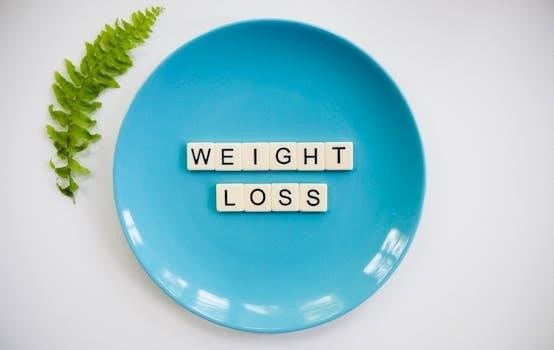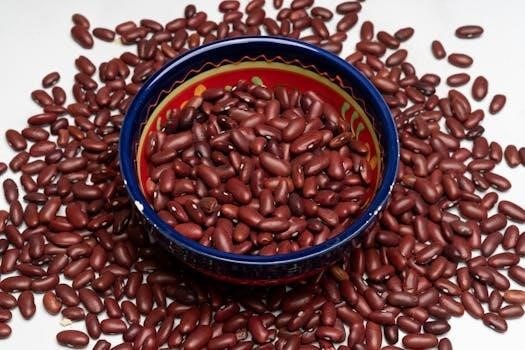Looking for a structured approach to carb cycling?
A PDF plan can be a great resource․ These downloadable guides often provide meal examples‚ macro breakdowns‚ and schedules․ They simplify the process‚ offering a convenient way to implement carb cycling for your fitness goals․
What is Carb Cycling?
Carb cycling is a dietary approach that involves strategically varying your carbohydrate intake on a daily or weekly basis․ Unlike traditional diets that maintain a consistent carb intake‚ carb cycling alternates between high-carb and low-carb days․ The primary goal is to optimize your body’s use of carbs for energy and muscle recovery‚ while also promoting fat loss․
The rationale behind carb cycling lies in aligning your carb intake with your activity levels․ On days when you engage in intense workouts‚ particularly those that deplete glycogen stores‚ you consume more carbs to fuel your performance and replenish those stores․ Conversely‚ on rest days or days with lower activity‚ you reduce your carb intake‚ encouraging your body to burn fat for fuel․
This approach can be tailored to individual needs and training schedules․ Some people may follow a daily cycle‚ while others opt for a weekly pattern․ The specific ratio of high-carb to low-carb days also varies depending on factors like training intensity‚ body composition goals‚ and individual tolerance․
Benefits of Carb Cycling
Carb cycling offers a range of potential benefits that make it an appealing dietary strategy for various individuals․ One key advantage is its ability to support both muscle growth and fat loss․ By strategically timing carb intake around workouts‚ you can provide your muscles with the necessary fuel for optimal performance and recovery‚ while also creating periods of lower carb intake to promote fat burning․
Another benefit is improved insulin sensitivity․ High-carb days can help improve insulin sensitivity‚ making your body more efficient at utilizing carbs․ This is especially beneficial for those who may have developed insulin resistance from prolonged low-carb dieting․
Carb cycling may also lead to better energy levels and reduced cravings․ Unlike constant low-carb diets that can cause fatigue and cravings‚ carb cycling allows for periods of higher carb intake‚ which can boost energy levels and satisfy carb cravings․ This can make the diet more sustainable in the long run․
Carb Cycling vs․ Traditional Low-Carb Diets
Carb cycling and traditional low-carb diets both aim to manage carbohydrate intake but differ significantly in their approach․ Traditional low-carb diets‚ such as the ketogenic diet‚ involve consistently restricting carbs to a very low level‚ often below 50 grams per day․ This forces the body to enter a state of ketosis‚ where it primarily burns fat for fuel․
In contrast‚ carb cycling involves alternating between high-carb and low-carb days․ This allows for greater flexibility and can be more sustainable for some individuals․ While low-carb days promote fat loss‚ high-carb days provide energy for workouts and help replenish glycogen stores․
A key difference lies in hormonal impact․ Prolonged low-carb diets can sometimes negatively affect hormones like thyroid and cortisol․ Carb cycling‚ with its periodic high-carb days‚ may help mitigate these hormonal imbalances․
Determining Calorie and Macro Needs for Carb Cycling
Before starting carb cycling‚ it’s crucial to determine your individual calorie and macro needs․ This involves calculating your Basal Metabolic Rate (BMR)‚ which is the number of calories your body burns at rest․ Then‚ factor in your activity level to estimate your Total Daily Energy Expenditure (TDEE)․
To lose weight‚ you’ll need to create a calorie deficit‚ typically by reducing your TDEE by 300-500 calories per day․ Next‚ determine your macro split․ Protein intake should remain relatively consistent across all days‚ aiming for around 0․8-1 gram per pound of body weight․
The primary adjustment in carb cycling is with carbohydrate and fat intake․ On high-carb days‚ increase your carbohydrate intake while reducing fat intake․ On low-carb days‚ do the opposite – decrease carbs and increase healthy fats; Adjust macro ratios according to your preferences and goals․
Calculating Carb Intake for High and Low-Carb Days
Calculating the right carb intake for high and low-carb days is essential for successful carb cycling․ Start by determining your target carb range for both types of days․ A common approach is to base carb intake on body weight․
For high-carb days‚ aim for 1․5 to 2․5 grams of carbs per pound of body weight․ These are typically your workout days‚ where your body needs more glucose for fuel․ On low-carb days‚ significantly reduce your carb intake to 0․5 grams or less per pound of body weight․
Remember that these are just starting points‚ adjust based on your body’s response and activity levels․ Track your progress and make gradual changes to find the carb intake that works best for you․ Consider using a calorie tracking app to monitor your intake․

Sample 7-Day Carb Cycling Meal Plan
Here’s an example of a 7-day carb cycling meal plan to give you an idea of how to structure your week․ This plan includes high‚ moderate‚ and low-carb days‚ tailored to different activity levels․ Remember‚ this is just a sample‚ and you should adjust it to fit your own needs and preferences․
Monday⁚ Low-Carb Day
Tuesday⁚ Moderate-Carb Day
Wednesday⁚ High-Carb Day
Thursday⁚ Low-Carb Day
Friday⁚ Moderate-Carb Day
Saturday⁚ High-Carb Day
Sunday⁚ Low or High-Carb Day (depending on your goals and activity level)
Each day includes breakfast‚ lunch‚ dinner‚ and snacks‚ with carb counts tailored to the specific day․ Remember to focus on whole‚ unprocessed foods and adjust portion sizes to meet your individual calorie needs․
High-Carb Day Example
On a high-carb day‚ the goal is to replenish glycogen stores and fuel intense workouts․ Here’s a sample meal plan for a high-carb day‚ designed around 2000 calories⁚
Breakfast⁚ Oatmeal with berries and nuts‚ providing complex carbs and fiber․
Lunch⁚ Chicken breast with sweet potato and mixed vegetables‚ offering a balance of protein and carbs․
Dinner⁚ Pasta with lean ground turkey and marinara sauce‚ focusing on easily digestible carbs․
Snacks⁚ Fruit smoothie with protein powder‚ whole-wheat crackers with avocado‚ ensuring sustained energy levels․
Remember to choose complex carbohydrates like whole grains‚ fruits‚ and vegetables over simple sugars․ Adjust portion sizes to fit your specific calorie needs and activity level․ Stay hydrated throughout the day to support your body’s utilization of carbohydrates․
Moderate-Carb Day Example
A moderate-carb day aims to provide a balanced intake of carbohydrates‚ protein‚ and fats․ Here’s a sample meal plan for a moderate-carb day‚ designed around 2000 calories⁚
Breakfast⁚ Eggs with whole-wheat toast and a side of fruit‚ offering a mix of protein and complex carbs․
Lunch⁚ Salad with grilled chicken or fish‚ quinoa‚ and a variety of vegetables‚ ensuring a balanced meal․
Dinner⁚ Lean protein (chicken‚ fish‚ or tofu) with brown rice and steamed vegetables‚ providing a moderate carb source․
Snacks⁚ Greek yogurt with berries‚ a handful of nuts‚ aiming for sustained energy and satiety․
The focus is on whole‚ unprocessed foods․ Adjust portion sizes to match your individual calorie and macro needs․ Consider your activity level when planning your meals․ Listen to your body’s hunger and fullness cues throughout the day․
Low-Carb Day Example
A low-carb day focuses on protein and healthy fats while significantly reducing carbohydrate intake․ This helps shift the body’s energy source towards fat burning․ A sample low-carb day meal plan (around 2000 calories) could look like this⁚
Breakfast⁚ Scrambled eggs with spinach and avocado‚ providing protein and healthy fats․
Lunch⁚ Large salad with grilled chicken or fish‚ plenty of non-starchy vegetables‚ and an olive oil-based dressing․
Dinner⁚ Steak or salmon with roasted vegetables like broccoli or asparagus‚ emphasizing protein and low-carb veggies․

Snacks⁚ A handful of almonds‚ a small serving of cottage cheese‚ or celery sticks with almond butter․
It’s crucial to prioritize nutrient-dense foods and stay hydrated․ Adjust portion sizes to fit your individual calorie needs․ Aim for a carb intake of less than 50 grams․
Foods to Eat on High-Carb Days
On high-carb days‚ the focus is on replenishing glycogen stores to fuel workouts and support muscle recovery․ Prioritize whole‚ unprocessed carbohydrate sources․ These foods provide sustained energy and essential nutrients․
Excellent choices include⁚
- Oats⁚ Versatile and fiber-rich‚ perfect for breakfast․
- Quinoa⁚ A complete protein source with a good carb content․
- Brown Rice⁚ A staple for a balanced meal․
- Sweet Potatoes⁚ Nutrient-dense and delicious․
- Fruits⁚ Bananas‚ apples‚ berries – provide natural sugars and vitamins․
- Legumes⁚ Beans and lentils offer carbs and protein․
- Whole-wheat pasta or bread⁚ Opt for whole-grain versions for fiber․
Remember to balance these carbohydrates with lean protein sources like chicken‚ fish‚ or tofu‚ and healthy fats from avocados or nuts․ Portion control is still important․
Foods to Eat on Low-Carb Days
Low-carb days shift the body’s energy source to fat‚ promoting fat burning․ Focus on foods that are high in healthy fats and protein while minimizing carbohydrate intake․ This doesn’t mean eliminating carbs entirely‚ but rather choosing non-starchy vegetables and limiting other sources․
Here’s a list of foods to prioritize⁚
- Non-starchy Vegetables⁚ Leafy greens‚ broccoli‚ cauliflower‚ peppers‚ and asparagus․
- Healthy Fats⁚ Avocados‚ nuts‚ seeds‚ olive oil‚ and fatty fish like salmon․
- Lean Proteins⁚ Chicken breast‚ turkey‚ fish‚ eggs‚ and tofu․
Foods to limit⁚

- Grains⁚ Rice‚ bread‚ pasta‚ and oats․
- Fruits⁚ High-sugar fruits like bananas and grapes․
- Legumes⁚ Beans and lentils․
- Starchy Vegetables⁚ Potatoes and corn․
Remember to stay hydrated and monitor your energy levels․ It’s crucial to ensure you’re consuming enough calories from fats and protein to maintain satiety and support your body’s functions․
Adjusting the Carb Cycling Plan Based on Training Intensity
The key to a successful carb cycling plan lies in tailoring it to your training intensity․ High-intensity workouts demand more readily available energy‚ making high-carb days essential․ Conversely‚ low-intensity or rest days require fewer carbs‚ allowing your body to tap into fat stores for fuel․
On high-intensity training days‚ prioritize complex carbohydrates like oats‚ quinoa‚ and sweet potatoes to replenish glycogen stores and fuel your performance․ On moderate-intensity days‚ reduce the carbohydrate portion size slightly‚ adding more protein and fats․ For low-intensity or rest days‚ focus on non-starchy vegetables‚ healthy fats‚ and lean protein․
General Guidelines⁚
- High-Intensity Days⁚ Higher carb intake (50% of calories from carbs)․
- Moderate-Intensity Days⁚ Moderate carb intake (30-40% of calories from carbs)․
- Low-Intensity/Rest Days⁚ Lower carb intake (less than 25% of calories from carbs)․
Adjusting your plan based on your individual needs is crucial․ Pay attention to your body’s signals and modify your carbohydrate intake accordingly․
Important Considerations and Potential Downsides
While carb cycling can be effective for some‚ it’s essential to consider potential downsides․ It requires meticulous planning and tracking‚ which may not be sustainable for everyone․ Consistency is key‚ and deviations can hinder progress․
Some individuals may experience fluctuations in energy levels‚ especially during the initial adaptation phase; Low-carb days might lead to fatigue or irritability․ It’s crucial to listen to your body and adjust the plan accordingly․
Important Considerations⁚
- Requires meticulous planning⁚ Track macros and plan meals carefully․
- Not suitable for everyone⁚ Individual responses may vary․
- Potential for energy fluctuations⁚ Low-carb days can cause fatigue․
- Consult a professional⁚ Seek guidance from a registered dietitian or healthcare provider․
It’s also important to note that carb cycling is not a magic bullet․ It’s most effective when combined with a balanced diet‚ regular exercise‚ and sufficient sleep․ Before starting any new diet‚ consult with a healthcare professional to ensure it’s appropriate for your individual needs and health conditions․
